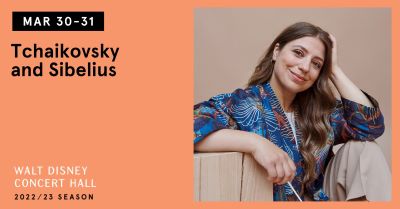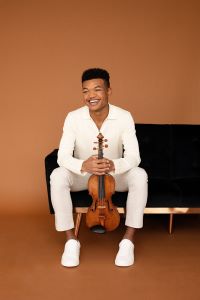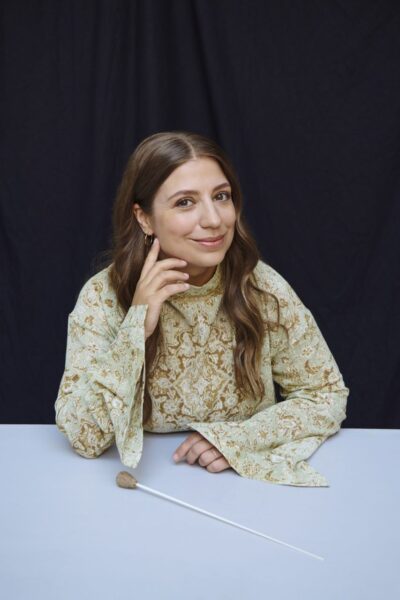STASEVSKA, STASEVSKA, STASEVSKA
There is much good news about this morning’s program with the LA Phil. Let me start with the most important. Dalia Stasevska, a 38-year-old Kyiv-born musician who lives in Finland, was the Guest Conductor (she is now the Principal Guest Conductor of the BBC Philharmonic). Say that Ukrainian last name over and over — Stasevska, Stasevska — because if I had my druthers, I’d like to see her — get ready for this — fill the shoes of Gustavo Dudamel when he leaves in three years to lead the NY Phil. (I also vote for American Roderick Cox, Lithuanian Mirga Gražinytė-Tyla, and Stasevska’s fellow Finn Esa-Pekka Salonen.) The phrase “I know it when I see it” comes to mind. Regal, commanding, emotional, exuberant, turbulent, coaxing, and generous, she led an LA Phil premiere of Andrea Tarrodi’s Liguria, Tchaikovsky’s Violin Concerto with Randall Goosby, and Sibelius’s Second Symphony, pulling sounds from our estimable orchestra rarely heard with a guest conductor. Wearing baggy black pants, a flowing dashiki jacket by Klaus Haapaniem, and a large solidarity ribbon promoting the cause of her home country, she brought nothing but joy to a packed house this morning. (Sadly, last night and today were the only performances.)
Have you been to the Cinque Terre in Italy? This iconic area is truly one of the most inspiring places to visit. It’s a five-town string of old fishing villages perched high on the Italian Riviera in the region Liguria — Liguria being the perfect title for Swedish composer Andrea Tarrodi’s 10-minute 2012 tone poem (a “walking tour” Tarrodi says), a wonderful souvenir inspired by her visit there; and it’s the first LA Phil performance. A majestic theme is heard beneath roaring cymbals, a threatening bass drum, and pounding timpani, after which an oboe adds an alluring, enchanting melody. As with Debussy’s La Mer, the seductive sounds evoking the waves of Riomaggiore have a precarious undertone from steady strings. Things get active from a flute, xylophone, a muted, raspy horn, and plucking from the strings. It starts off twinkly and bright, followed by a crescendo of thunderous brass. Then mystery as the awesomeness of time is captured with chimes evoking a clock tower in a star-filled sky, fading to silence. It was a rapturous interpretation from Stasevska, who invited up to the stage Ms. Tarrodi, who was born in Stockholm in 1981. I am thrilled that a new miniature work, one which truly does conjure up mental images, instead of one which is the same-old atmospheric soundscape sci-fi stuff we’ve been getting.
Randall Goosby has proven to me that he is without a doubt the master of the sweetest tones I have ever heard on the violin. With a buttered cream technique that belies the perfect fingering and light but firm bowing, he stands out from all of his fellow violinists. Why? He has created a silky sound that nonetheless can be heard to the back of the house at Disney Hall. This is no showman — the violin is in his soul, and it will surely reach yours. Thus, he performed Tchaikovsky’s Violin Concerto very sweet, soft and sensitive, versus, say Augustin Hadelich, who adds more power and drama to the work (my review title for Hadelich doing the same piece was “Hot Augustin Night”). Goosby is the Peggy Lee of violinists — Lee knew that singing even softer, she would manage to get the attention of the audience and could give a large concert hall the allure of an intimate recital.
Stasevska understood this, so she kept the smaller orchestra hushed with strong articulation such that the violin was never drowned out. This made the entrances into the famous fanfare even more rousing, and the crescendos more powerful. Goosby was strong in the Andante, but he took a more prudent approach to the cadenza; instead of showy trills and long-held top notes, he went for clarity, clarity, clarity. Yet while he was in no rush, he maintained a fervent energy. His interpretation of the concerto was very different from the dozens I’ve seen live, but that made it no less valid. And in the “you-can’t fool-an-audience” department, he received a stentorian standing ovation. He offered a jocular reading of Coleridge-Taylor Perkinson‘s “Louisiana Blues Strut (A Cakewalk).”
The true revelation came after the interval with Sibelius. Stasevska studied violin, viola, and conducting at the Sibelius Academy and is Artistic Director of the International Sibelius Festival. PLUS, she is married to the Finnish musician and composer Lauri Porra, the great-grandson of Jean Sibelius. So it’s fitting that her rendition of the well-known Second Symphony was a masterpiece. As if coursing through her blood, she insisted a firm, majestic and massive sound from the strings, even when they were plucking. And oboist Marc Lacha filled the hall with heroic, optimistic fortitude and a somber touch. Stasevska was authoritative in Andante ma rubato, urging — almost beseeching with love — in the fast but fleeting third movement, and entirely magnanimous in the Fourth and final movement, making this performance the most emotionally invigorating of the Second Symphony that I have ever heard.
Stasevska, Stasevska, Stasevska.
ph0tos courtesy of LA Phil
TCHAIKOVSKY AND SIBELIUS
LA Phil
Guest Conductor Dalia Stasevska; Violin Randall Goosby
for more concerts, visit LA Phil



